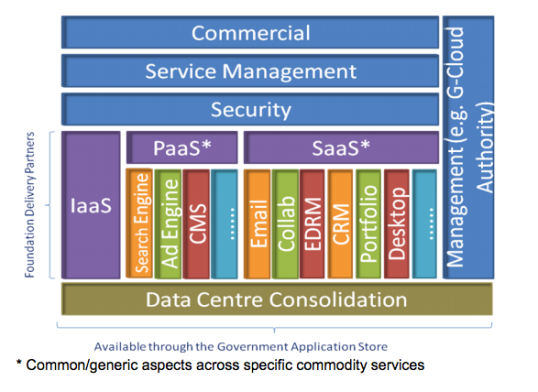Executive Brief
A number of governments have implemented roadmaps and strategies that ultimately require their ministries, departments and agencies to default to Cloud computing solutions first when evaluating IT implementations. In this article, we evaluate the adoption of cloud computing in government and discuss some of the positive and negative implications of moving government IT onto the cloud.
Latest Trends
In this section, we look at a number of cloud initiatives that have been gaining leeway in the public sector:
- Office Productivity Services – The New Zealand Government has identified office productivity services as the first set of cloud-based services to be deployed across government agencies. Considered to be low hanging fruit and fueled by successes in migrating perimeter services like anti-spam onto the cloud, many organizations see email and collaboration as a natural next step of cloud adoption. Vendors leading the charge include Microsoft’s Office 365 for Government, with successful deployments including Federal Agencies like the USDA, Veterans Affairs, FAA and the EPA as well as the Cities of Chicago, New York and Shanghai. Other vendor solutions include Google Apps for Government which supports the US Department of the Interior.
- Government Cloud Marketplaces – A number of governments have signified the need to establish cloud marketplaces, where a federated marketplace of cloud service providers can support a broad range of users and partner organizations. The UK government called for the development of a government-wide Appstore, as did the New Zealand Government in a separate cabinet paper on cloud computing in August 2012. The US government has plans to establish a number of cloud services marketplaces, including the GSA’s info.apps.gov and the DOE’s YOURcloud, a secure cloud services brokerage built on Amazon’s EC2 offering. (link) The image below lists the initial design for the UK government App store.

- Making Data publicly available – The UK Government is readily exploiting opportunities to make available the Terabytes of public data that can be used to develop useful applications. The recent release of Met Office UK Weather information to the public via Microsoft Azure’s cloud hosting platform. (link)
- Government Security Certification – A 2012 Government Cloud Survey conducted by KPMG listed security as the greatest concern for governments when it comes to cloud adoption and that governments are taking measures to manage security concerns. For example, the US General Services Administration subjects each successful cloud vendor to a battery of tests that include an assessment of access controls.

Canadian Government Cloud Architectural Components
Strategic Value
The strategic value of cloud computing can be summed up into a number of key elements in government. We’ve listed a few that appear on the top of our list:
- Enhancing agility of government – Cited as a significant factor in cloud adoption, cloud computing promises rapid provisioning and elasticity of resources, reducing turnaround times on projects.
- Supporting government policies for the environment – The environmental impact due to reduced data center spending and consumption of energy on cooling has tangible environmental benefits in terms of reduced greenhouse gas emissions and potential reductions in allocations of carbon credits.
- Enhancing Transparency of government – Cloud allows the developed of initiatives that can make government records accessible to the public, opening up tremendous opportunities for innovation and advancement.
- Efficient utilization of resources – By adopting a pay-for-use approach towards computing, stakeholders are encouraged to architect their applications to be more cost effective. This means that unused resources are freed up to the common pool of computing resources.
- Reduction in spending – Our research indicated this particular element is not considered to be a significant aspect of moving to cloud computing according to technology decision makers, however some of the numbers being bandied about in terms of cost savings are significant (Billions of dollars) and can appeal to any constituency.
Positive Implications
We’ve listed a number of positive points towards cloud adoption. These may not be relevant in every use case, but worthwhile for a quick read:
- Resource Pooling – leads to enhanced efficiency, reduced energy consumption and more economical cost savings from scale
- Scalability – Unconstrained capacity allows for more agile enterprises that are scalable, flexible and responsive to change
- Reallocation of human resources – Freed up IT resources can focus on R&D, designing new solutions that are optimized in cloud environments and decoupling applications from existing infrastructures.
- Cost containment – Cloud computing requires the adoption of a ‘you pay for what you use’ model, which encourages thrift and efficiency. The transfer of CAPEX to OPEX also smoothes out cash-flow concerns in an environment of tight budgets.
- Reduce duplication and encourage re-use – Services designed to meet interoperability standards can be advertised in a cloud marketplace and become building blocks that can be used by different departments to construct applications
- Availability – Cloud architecture is designed to be independent of the underlying hardware infrastructure and promotes scalability and availability paradigms such as homogeneity and decoupling
- Resiliency – The failure of one node of a cloud computing environment has no overall effect on information availability
Negative Implications
A sound study should also include a review of the negative implications of cloud computing:
- Bureaucratic hinderances – when transitioning from legacy systems, data migration and change management can slow down the “on demand” adoption of cloud computing.
- Cloud Gaps – Applications and services that have specific requirements which are unable to be met by the cloud need to be planned for to ensure that they do not become obsolete.
- Risks of confidentiality – Isolation has been a long-practiced strategy for securing disparate networks. If you’re not connected to a network, there’s no risk of threats getting in. A common cloud infrastructure runs the risk of exploitation that can be pervasive since all applications and tenants are connected via a common underlying infrastructure.
- Cost savings do not materialize – The cloud is not a silver bullet for cost savings. We need to develop cloud-aligned approaches towards IT provisioning, operations and management. Applications need to be decoupled and re-architected for the cloud. Common services should be used in order to exploit economies of scale; applications and their underlying systems need to be tweaked and optimized.
Security was cited as a major concern (KPMG)
Where to start?
There is considerable research that indicates government adoption of cloud computing will accelerate in coming years. But to walk the fine line of success, what steps can be taken? We’ve distilled a number of best practices into the following list:
- Develop Roadmaps: Before Cloud Computing can reap all of the benefits that it has to offer, governments must first move along a continuum towards adoption. For that very purpose, a number of governments have developed roadmaps to aid in developing a course of progression towards the cloud. Successful roadmaps featured the following components:
- A technology vision of Cloud Computing Strategy success
- Frameworks to support seamless implementation of federated community cloud environments
- Confidence in Security Capabilities – Demonstration that cloud services can handle the required levels of security across stakeholder constituencies in order to build and establish levels of trust.
- Harmonization of Security requirements – Differing security standards will impede and obstruct large-scale interoperability and mobility in a multi-tenanted cloud environment, therefore a common overarching security standard must be developed.
- Management of Cloud outliers – Identify gaps where Cloud cannot provide adequate levels of service or specialization for specific technologies and application and identify strategies to deal with these outliers.
- Definition of unique mission/sector/business Requirements (e.g. 508 compliance, e-discovery, record retention)
- Development of cloud service metrics such as common units of measurement in order to track consumption across different units of government and allow the incorporation of common metrics into SLAs.
- Implementation of Audit standards to promote transparency and gain confidence
- Create Centers of Excellence: Cloud Computing Reference Architectures; Business Case Templates and Best Practices should be developed so that cloud service vendors should map their offerings to (i.e. NIST Reference Architecture) so that it is easier to compare services.
- Cloud First policies: Implementing policies that mandate all departments across government should consider cloud options first when planning for new IT projects.
Conclusion
The adoption of cloud services holds great promise, but due to the far reaching consequences necessitated by the wide-spread adoption of cloud to achieve objectives such as economies of scale, a comprehensive plan compounded with standardization and transparency become essential elements of success.
We hope this brief has been useful. Ook!
Useful Links
Microsoft’s Cloud Computing in Government page
Cisco’s Government Cloud Computing page
Amazon AWS Cloud Computing page
Redhat cloud computing roadmap for government pdf
US Government Cloud Computing Roadmap Vol 1.
Software and Information Industry updates on NIST Roadmap
New Zealand Government Cloud Computing Strategy link
Australian Government Cloud Computing Strategic Direction paper
Canadian Government Cloud Computing Roadmap
UK Government Cloud Strategy Paper
GCN – A portal for Cloud in Government
Study – State of Cloud Computing in the public sector


